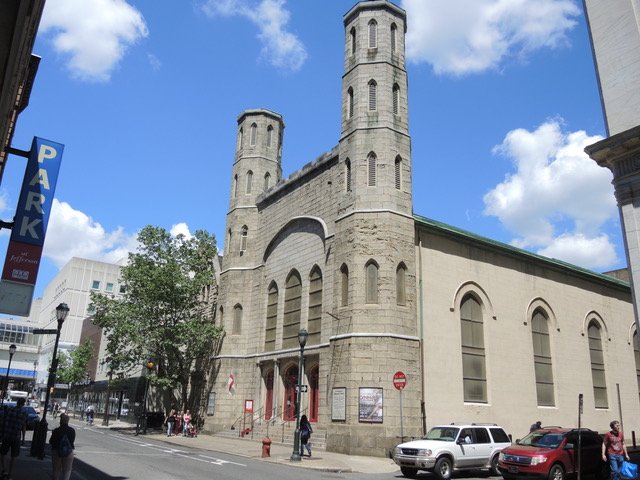Friday Anniversary Perspectives Opened Up Close: Life Within Our Stone
Detail, St. Stephen’s stone façade
I hope we never take for granted our startling “Gothic” church that engages so intimately with our sidewalks and streets, and offers its “stoop” as seating.
Its physical body, I found when I began to look, even offers much to contemplate.
General view, St. Stephen’s today
The towered face of St. Stephen’s, a brick building that’s otherwise stuccoed and painted, is clad in gritty light-colored stone. Okay, a reference to medieval [e.g. European] stone churches. Yet it also links St. Stephen’s to other public buildings that its architect William Strickland designed for Philadelphia during these very years, also built of stone, like the nearby Second National Bank, homage to Athens’ Parthenon.
The materials of the two buildings nonetheless also speak of nearby roots. The Second Bank’s “Greek” marble facade is a “blue” marble quarried 30 miles away.
Using local stone is standard across the centuries. It’s cheaper and practical. AND it powerfully advertises the building’s local identity and loyalty.
St. Stephen’s stone face, I believe, offers a comparable story that I can’t document yet. Early histories claim the stone is Quincy granite, quarried south of Boston but used widely. St. Stephen’s 2017 structural condition report calls the stone sandstone for its consistency and weathering. In a later informal exchange, structural engineer Jonathan Price proposed yet another alternative: Wissahickon schist.
This native, widely-used stone, however, has a dramatic origin story.
Wissahickon schist is deeply ancient metamorphic stone (stone that underwent many changes) that remains the predominant bedrock under the Philadelphia region. It began as gravel on a onetime sea floor there, combining deposits of many materials from distant places that were eventually compressed into shale and, yes, sandstone—but that continued to metamorphose under tremendous pressure and heat when volcanic action thrust it upward as mountain ranges. This may be familiar geology but it conjures breathtaking spectacle.
Wissahickon Gorge and Creek
The bedrock was eventually called the Wissahickon Formation for the Wissahickon Gorge, with its cascading stream that flows through the bedrock to the Schuylkill River, then into the Delaware.
The stone quarried from this formation became known as Wissahickon schist or Chestnut Hill stone for a town established in the area. Thanks to its cumulative nature, Wissahickon schist enjoys great surface vitality: It offers various colors, textures, and mineral inclusions, notably the reflective mica that characterizes our stone.
Jon’s proposal that St. Stephen’s primary façade was given this stone is compelling. We’ve been offered a deeper bond with Place: St. Stephen’s stone face connects us to the ancient, roiling earth beneath and around us.
We look at this “stable” stone façade, with its contrasting rough and smooth areas worked by masons, and imagine the time, energy, and radical changes that each block embodies. I imagine how diverse its elements are and how far away some of them began their journeys in an unimaginably different Earth.
That’s like life, like us, mobile, diverse, engaging with ongoing forces.
That’s a vitality that I sense in the façade’s quiet light as I approach, then up close, in the mica flickering in response to sunbeams. There, this weathered stone asserts its life and ongoing engagement with its world. Including us. We gain so much by noticing and opening our minds through it.
— Suzanne Glover Lindsay, St. Stephen’s historian and curator


